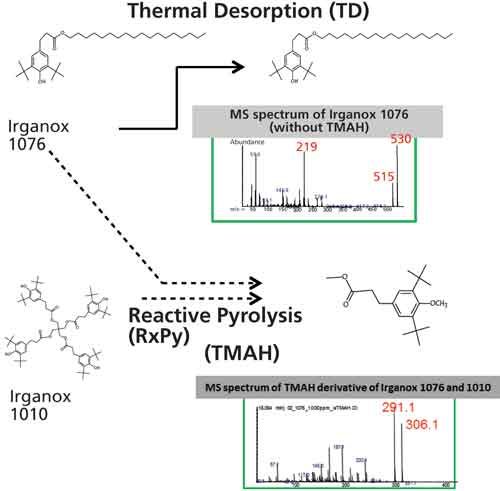Characterization and Determination of Irganox 1076 and 1010 in Polyethylene Using Thermal Desorption and Reactive Pyrolysis-GC-MS
Special Issues
This application note details a GC-MS-based analytical method for the qualitative and quantitative determination of Irganox 1076 and 1010 in polyethylene.
Two of the more commonly used polymer additives, Irganox 1076 and 1010, are phenolic primary antioxidants used to provide long-term thermal stability to the end product. They are widely used in polyolefins such as polyethylene, polypropylene, polybutene, and copolymers such as polyurethane. Analysis of 1076 and 1010 is difficult because each is highly resistant to conventional extraction and has a very low vapor pressure. It is not unusual for a laboratory to use HPLC or LC-MS for these two additives. Note that both additives have the exact same phenolic group in the ratio of 4:1.
This application note details a GC-MS-based analytical method for the qualitative and quantitative determination of Irganox 1076 and 1010 in polyethylene.
Irganox 1076 can be thermally desorbed from polyethylene at 320 °C. The mass spectrum has a base peak of m/z 530-representing the molecular ion. Both 1076 and 1010 have an ester linkage which can be thermally hydrolyzed and methylated using tetramethylammonium hydroxide (TMAH). The derivatized product is the same for both 1010 and 1076; the mass spectra of the derivatized additives are also identical and exhibit large peaks at m/z 291 and 306. The stoichiometric ratio of the derivatized product compound for Irganox 1010 is 4:1 compared to Irganox 1076. Reactive pyrolysis alone cannot be used to differentiate Irganox 1076 and 1010. See Figure 1.

Figure 1: Both 1076 and 1010 have an ester linkage which can be thermally hydrolyzed and methylated using tetramethylammonium hydroxide (TMAH). Reactive pyrolysis alone cannot be used to differentiate Irganox 1076 and 1010.
It is a relatively straight forward process to identify and quantitate both Irganox 1010 and 1076 in polyethylene. Analysis of the sample using reactive pyrolysis (RxPy) yields the total ppm of the two additives. A second analysis of the sample using thermal desorption quantitates the Irganox 1076. Subtracting the two numbers is all that is necessary to find the amount of Irganox 1010:
1010 & 1076 (RxPy) total – 1076 (TD) = 1010 amount.
Example shown in Table I for the PE unknown sample where the calculated amount of 1010 is 1406 ppm.

CLICK TABLE TO ENLARGE
Complex samples can rarely be fully characterized using a single analytical technique; consequently, the analyst must analyze the sample a number of times using different analytical tools. This work clearly illustrates the value of having a chromatographic system that can be configured to perform multiple analytical techniques. The EGA/PY-3030 Multi-shot Pyrolyzer from Frontier Laboratories can be used to characterize a sample using evolved gas analysis, pyrolysis, multi-zone thermal desorption, and reactive pyrolysis. Both liquid and solid samples can be analyzed directly; conventional sample prep regimes are unnecessary. More complete information regarding this analysis is contained in a technical brief from the authors.
Itsuko Iwai, R.R. Freeman, and Dave Randle, are with Frontier Laboratories. Terry Ramus is with Diablo Analytical.

Frontier Laboratories, Ltd.
Koriyama, Fukushima, Japan
tel. +81-24-935-5100
